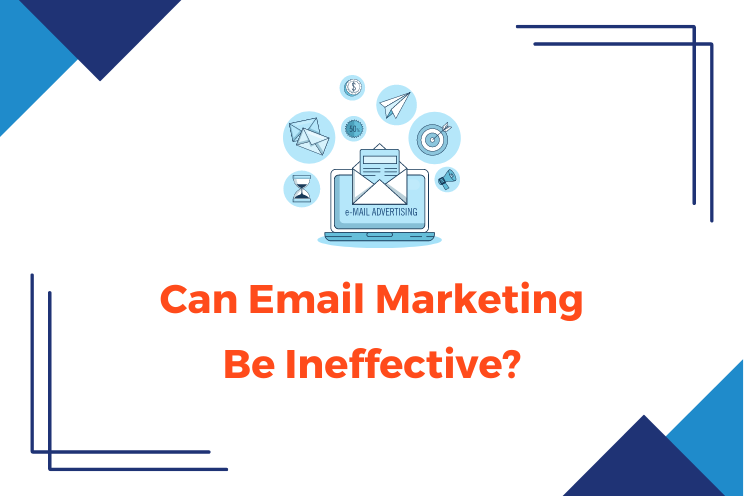You’re here because you’re asking a tough question: “Can email marketing be ineffective?” The answer is simple—yes, it can.
Email marketing is one of the most powerful tools in your arsenal, but only if you know how to use it. The harsh reality is that most people get it wrong, and that’s why their campaigns flop. If your emails aren’t getting opened, clicked, or converting, your strategy is broken. But here’s the good news: you can fix it.
In this article, I’m going to show you why email marketing can be ineffective and, more importantly, how to turn things around. We’ll cover everything from poor targeting and spam filters to lackluster content and low engagement. No fluff, just actionable insights you can use right now. By the end, you’ll know exactly how to avoid the traps that make email marketing fail.

What Makes Email Marketing Ineffective?
Email marketing is a game-changer—when done right. But when done wrong, it’s just a waste of time. Here’s why email marketing can be ineffective, and how to avoid falling into these common traps.
Poor Targeting and Segmentation
Sending the same email to everyone? Stop. Now. Poor targeting is a surefire way to kill your email marketing efforts. If you’re not segmenting your audience, you’re throwing darts in the dark. People want personalized messages that speak directly to them. Without proper segmentation, expect low engagement and high unsubscribe rates. Why? Because your message isn’t hitting the mark.
Key takeaway: Segment your audience. The more specific you are, the better your results.
Ineffective Subject Lines
Your subject line is the gatekeeper. If it doesn’t grab attention, your email goes straight to the trash. An ineffective subject line equals low open rates. It’s like having a great product, but keeping the store closed. No one’s coming in if they don’t like what they see first.
Key takeaway: Spend time crafting compelling subject lines. Test them, tweak them, and don’t settle for mediocre.
Spam Filters
Spam filters are ruthless. If your emails aren’t getting past them, it doesn’t matter how good your content is—it’s not being seen. Triggers like poor subject lines, excessive links, or even the wrong words can land your email in the spam folder. If your deliverability is tanking, your emails are as good as dead.
Key takeaway: Avoid spammy language and ensure your emails are coming from a reputable sender.
Lack of Personalization
Nobody wants to feel like they’re just another name on a list. Generic emails get ignored. If your emails aren’t personalized, your audience tunes out. Personalization isn’t just a nice-to-have—it’s a must. It’s about delivering content that resonates on a personal level. Skip this, and you’re wasting a golden opportunity.
Key takeaway: Use data to personalize your emails. Make your audience feel like you’re speaking directly to them.
Inadequate Content and Value
Content is king, but only if it’s valuable. If your emails are just sales pitches or boring updates, don’t be surprised when your open rates drop. Your audience wants content that educates, entertains, or solves a problem. Anything less is a waste of time—for them and for you.
Key takeaway: Focus on delivering value. Make your content worth opening and reading.
How to Identify and Correct Ineffective Email Marketing Campaigns
Identifying why your email marketing is failing is the first step. Fixing it comes next. Here’s how to diagnose and correct the issues holding your campaigns back.
Analyzing Campaign Metrics
Metrics don’t lie. If your open rates, click-through rates (CTR), and conversion rates are low, something’s off. Low open rates? Your subject lines or deliverability might be to blame. Poor CTR? Your content or CTA needs work. No conversions? You’re not reaching the right audience.
Key takeaway: Use metrics to identify weak spots. Then, target those areas for improvement.
Testing and Optimization
A/B testing isn’t optional—it’s essential. Test everything: subject lines, content, send times. The goal is to find what works and ditch what doesn’t. But remember, change one variable at a time. That way, you know exactly what’s making the difference.
Key takeaway: Always be testing. Optimization is an ongoing process, not a one-time fix.
Improving Deliverability
If your emails aren’t reaching inboxes, nothing else matters. To improve deliverability, steer clear of spammy language, reduce the number of links, and use a reputable sender address. Encourage your subscribers to add you to their address book. Make your emails look as legitimate as possible.
Key takeaway: Focus on deliverability. If your emails aren’t getting delivered, you’re wasting your time.
Enhancing Audience Segmentation
Not all subscribers are the same. Segment your audience based on behaviors like purchase history, engagement levels, or interests. The more tailored your messages, the better they’ll perform.
Key takeaway: The more specific your segmentation, the more effective your emails will be.
Boosting Engagement through Personalization
Personalization goes beyond using a first name. It’s about sending the right message at the right time, based on what you know about your audience. Use behavioral triggers to send relevant content. The more relevant your emails, the higher the engagement.
Key takeaway: Make your emails personal and relevant. Engage your audience by meeting their needs.
Common Pitfalls and How to Overcome Them
Even the best email marketers fall into traps. Here’s how to avoid the common pitfalls that make email marketing ineffective.
Ignoring Segmentation
Sending generic emails is a waste of time. Without segmentation, your emails won’t resonate, leading to low engagement. It’s one of the biggest mistakes you can make in email marketing.
Solution: Invest time in proper segmentation. It’s worth the effort.
Neglecting Subject Lines
Your subject line is the most critical part of your email. If it’s weak, everything else is irrelevant. This is where many campaigns fail before they even start.
Solution: Prioritize your subject lines. Test and optimize them until they work.
Overlooking Deliverability
If your emails are flagged as spam, they’re dead on arrival. Deliverability issues can cripple your entire email marketing strategy.
Solution: Focus on improving deliverability. Avoid spam triggers and use a reputable sender address.
FAQs
Is email marketing still effective?
Yes, but only if done right. Ineffective strategies make it a waste of time, but with proper targeting, segmentation, and valuable content, email marketing can be highly effective.
What are the signs of an ineffective email campaign?
Low open rates, high unsubscribe rates, and poor conversion rates are clear indicators that your email marketing isn’t working.
How can I improve my email marketing?
Start by analyzing your metrics to identify weak spots. Focus on improving targeting, personalizing content, and ensuring your emails pass through spam filters.
What should I avoid in email marketing?
Avoid sending generic emails, using weak subject lines, and failing to segment your audience. These mistakes lead to low engagement and poor results.
Can spam filters affect my email marketing results?
Absolutely. If your emails are flagged as spam, they may never reach your audience. Focus on improving deliverability to ensure your emails land in the inbox.
Conclusion
So, can email marketing be ineffective? Absolutely—but it doesn’t have to be. The key is to understand where most people go wrong: poor targeting, weak subject lines, deliverability issues, and lack of personalization. Fix these, and you’ll see your email marketing efforts turn around.
Remember, it’s about delivering the right message to the right person at the right time. Stay focused on providing value, keep your emails relevant, and never stop optimizing. When you do that, email marketing isn’t just effective—it’s unstoppable.
